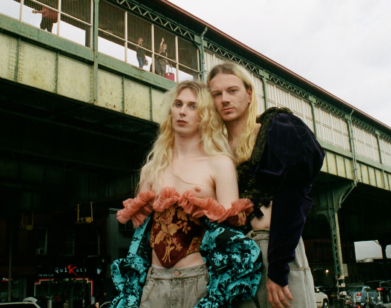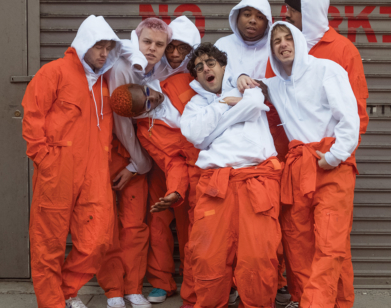Why millennial boy bands like Brockhampton and PRETTYMUCH are streaming themselves

On January 13th, 2016, an earthquake erupted in the online fandom world. One Direction announced an indefinite hiatus, effectively marking the end of an era. In their five years of harmonious glory, they sold 70 million records, performed to packed stadiums, and even met the Queen of England. But now that Zayn Malik and Harry Styles had moved on to dating supermodels and starring in moody war films, respectively, there was a void left in the fanatical, lucrative sphere of boy band fandom: who could possibly be next?
Brockhampton, a 14-member hip-hop collective, and PRETTYMUCH, the latest Simon Cowell iteration of the boy band, have emerged as possible heirs to the throne by using self-surveillance as a marketing gimmick. Through filming themselves living together in a band house, they have ingeniously established an interactive, intimate rapport with legions of fans. In the social media age, there’s a conundrum to marketing a pop group. Platforms like Twitter, Snapchat, and Instagram are designed for individualized expression; groups have to present a singular, cohesive brand.
Although boy bands inevitably splinter into solo careers, during the group’s ascent into popularity, they have to act like the show will go on forever. They can flex their individual quirks and talents in group interviews, but for the most part, they have to project an image of working together towards a common goal. In Brockhampton’s and PRETTYMUCH’s content, the highly interactive broadcasting of the band house serves as their marketing ethos. By pulling open the curtain and showing themselves creating, eating, and sleeping together, they reconcile each band member’s individual identity with the collective’s brand. Though it remains to be seen whether either of these groups can reach One Direction levels of notoriety, their self-surveillant marketing speaks to the evolution of the boy band product and demonstrates how a dystopian fear like the complete loss of all privacy can be repackaged and sold as youthful dynamism.
During the second half of 2017, Brockhampton, self-described “America’s favorite boy band,” managed to release three full length albums, a dozen music videos, a short film, and a documentary as part of their Saturation project. By the start of 2018, they reached two million monthly streams on Spotify—a triumph for an independent music group that less than a year ago was mostly famous on Tumblr. But this virality is no happy accident. Every facet to the group’s story makes them ripe for Generation Z mythologizing: Kevin Abstract founded the group in San Marcos, Texas, after posting to a Kanye West fan forum asking if anyone wanted to form a band. He then decided they should move in together after noticing how in The Social Network [2010], Mark Zuckerberg moved his coworkers into a Palo Alto house. Their music videos are lo-fi, using their neighborhood and home as backdrops and a golf cart, cheap costumes, face paint, and household staples like orange juice and cereal for props. Ultimately, they navigate the music industry as self-sufficient creatives well-versed with the internet, handling everything from graphic design to music videos to album production in-house. According to Ophir Admony, an A&R project manager at Terrible Records, this “closed circuit approach” creates “a culture and lifestyle to buy into, not just a mixtape.” Their VICELAND series American Boyband captures the creation of this prescient lifestyle brand.
Within the first few minutes of the pilot, Abstract goes live on Instagram to stream Romil Hemnani, the group’s producer and DJ, giving a tour of the the house. Holding a microphone, Hemnani says, “What’s up white America? We are at the Brockhampton factory in South Central, Los Angeles, and Brockhampton is a collective of multimedia artists who all met on a Kanye West fan forum. Let’s take a tour.” Hemnani walks through their cluttered home as Abstract films a couple members of the group acting apathetic. Sitting on a couch, Ameer Vann half-heartedly jokes: “I make hot tracks.” Most of their music videos are entertaining and bizarre; these Instagram live sessions are strategically mundane and off-kilter.
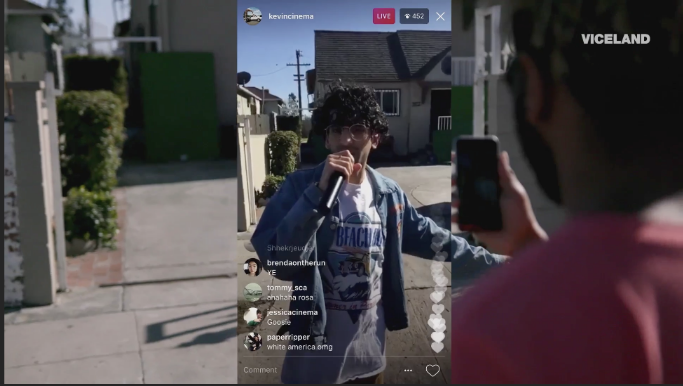
Screenshot of Hemnani’s house tour
For Brockhampton’s mostly young audience, the accessible nature of their content is an intrinsic part of their appeal. Gabby, 19, the owner of a Brockhampton Canada fan Twitter, said they are different from other boy bands because “they run their own media, it’s not a media department in a huge office building—it’s Ashlan with the camera and the boys on their phones, it’s you and me hanging out but they’re actually doing shit.” Nathaniel, 16, said that unlike other celebrities, Brockhampton doesn’t post “a bunch of fake stuff” on their social media. He wishes that he, too, can one day live and create in a house with his friends. As a highly active member of their Subreddit, Nathaniel described Brockhampton as “an experience” that can only be understood if you “experience it yourself.” These fans view the band house just as Abstract advertised it to be—a space of non-stop creativity, camaraderie, and innovation.
Unlike Brockhampton, PRETTYMUCH is a traditional pop group backed by a major label. But in a similar vein to “America’s favorite boy band,” their ascent is rooted in a democratized perception of social media and strategic self-surveillance. In interviews, they repeat the same story: each member had a Vine or YouTube presence that attracted the attention of Simon Cowell’s A&R team. Then, they moved into a house together and underwent a song-and-dance training bootcamp. They maintain that even though training to be a pop sensation is rigorous work, their brotherhood makes it all worth it. If Brockhampton is the ultimate fantasy of a group of passionate friends conquering the internet together, PRETTYMUCH is the ideal outcome for any ambitious teen or tween uploading a YouTube cover. In an interview for The Zach Sang Show, Zion Kuwonu, one of the group’s five members, describes being surprised when he was initially contacted by a talent scout, because he only had 150 Vine followers. “I just posted Vines to get girls at school and then Sony was like, come to this audition,” he recalled.
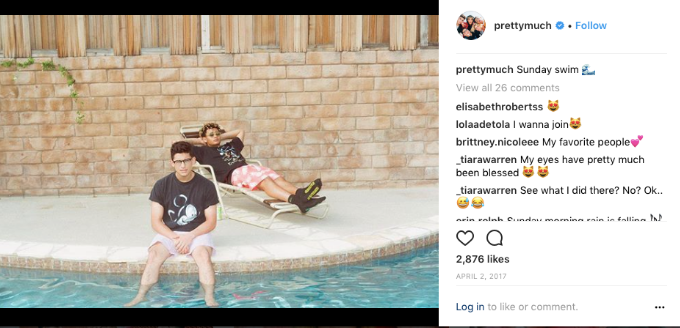
Brandon Arreaga and Zion Kuwonu of PRETTYMUCH
PRETTYMUCH Explains Everything, a web series for the AwesomenessTV YouTube channel, intersperses skits, interviews, screenshots taken from their social media, and clips of the band at their house. One moment they are sunbathing; the next, Nick Mara, the jock of the group, is throwing the TV into a pool because he’s angry about a sports game. They are the perfectly palatable counterpart to the unabashed obnoxiousness of Jake Paul’s Team 10, another high budget project of young men surveilling themselves from a suburban house for an audience of millions. As a product of social media scouting, this approach fits them well. When an independent act like Brockhampton nicknames their house a “factory” there’s a tinge of irony. PRETTYMUCH, however, is very much a product of what John Seabrook referred to as “the song machine.” Their web series is reminiscent of when K-pop group Girl’s Day revealed their dormitory in a series of vlogs—a glimpse of intimacy broadcasted from a tightly controlled bootcamp.
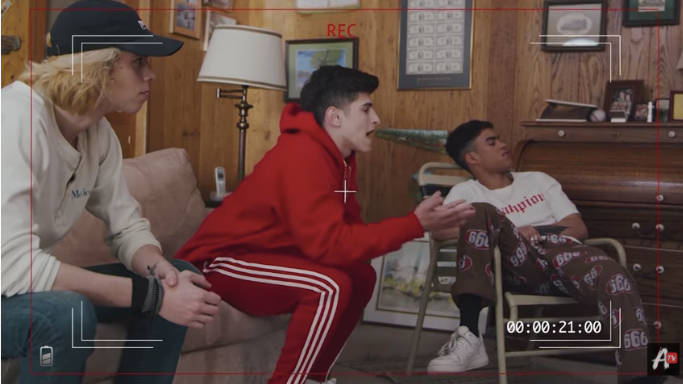
Screenshot from PRETTYMUCH Explains Everything
This kind of interactive, self-surveillant marketing was predicted nearly two decades ago. In 1999, years before Brockhampton and PRETTYMUCH would gleefully go “live” for adoring fans, internet entrepreneur Josh Harris locked 100 people in a lower Manhattan bunker installed with 110 security cameras and 100 capsule beds. The 24/7 surveillance performance art piece, titled “Quiet: We Live in Public” was the subject of Ondi Timoner’s 2009 documentary We Live in Public. When tech history is written, Steve Jobs, Bill Gates, and Jeff Bezos will be idolized as visionaries who pushed humanity forward. And perhaps in a footnote, Josh Harris will be mentioned as a quirky, dark prophet.
After making millions in as a tech consultant, in 1993, Harris started Pseudo, an online network that was an eclectic mix of news, music programs, and talk shows. Despite being riddled with glitches, Pseudo was undoubtedly ahead of its time, featuring chat-rooms, niche content, and video streams that are now part of all social media platforms and media sites. In 1994, Timoner started working at Pseudo as a side-gig. Five years later, Timoner received a phone call from Harris, asking her if she wanted to “document social history” and film his “live art installation” marking the “turn of the millennium.” After visiting the installation and witnessing the spectacle of security cameras and capsule beds, Timoner enthusiastically agreed to be both a participant and documentarian of the “Quiet” project. Ten years later, she logged onto Facebook and saw that her friend’s mundane status about driving on a freeway was being greeted with a steady stream of comments. Panicked that Harris’s predictions had become a reality, she spent the next eight months cutting 5000 hours of footage into an 84 minute documentary about “Quiet” and the world that came after it.
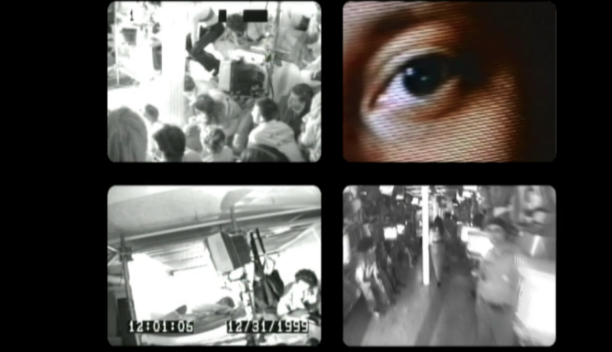
Screenshot from We Live in Public
Though “Quiet” was an overt Orwellian commentary on the internet’s future, it also poignantly revealed the participants’ own embrace of surveillance for notoriety and affirmation. Timoner’s documentary explores the power dynamic between Harris and his participants. In the self-contained capsule hotel, Harris gave all his participants an abundance of food, drugs, alcohol, entertainment, and even guns, in exchange for their privacy, and, in some particularly ominous cases, their sanity. On January 1st, 2000, “Quiet” was shut down by a SWAT team who suspected that the non-stop rave was a Millennium cult.
While “Quiet” showed adults descending into Bachannalian insanity, the content being live-streamed from Brockhampton’s and PRETTYMUCH’s phones is measured, appealing, and productive. Fans feel as if they are being granted access to an intimate “experience.” Part of their success is making self-surveillant marketing seem effortless, as opposed to contrived.
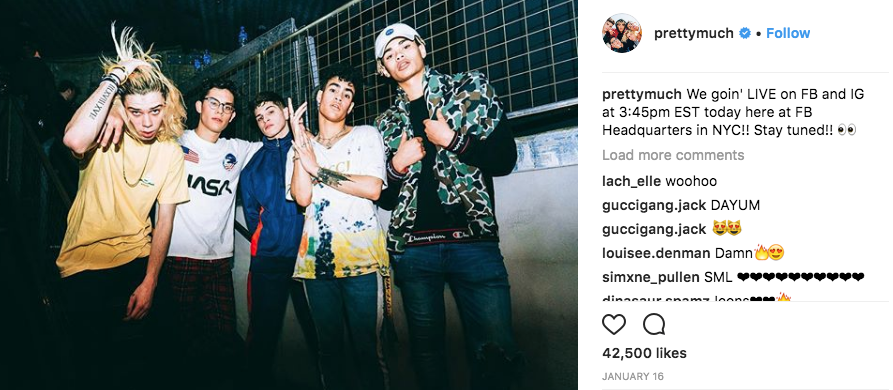
In 2017, to promote her album Witness, Katy Perry live streamed her house for 96 hours. The cameras ever-so-conveniently captured a conversation with activist DeRay Mckesson and a socially conscious lunch discussion starring Van Jones, Amanda Seales, Margaret Cho, and Caitlyn Jenner. Instead of striking a chord of intimacy, Perry seemed choreographed and desperate to rebrand as “woke.” Her album went on to underperform. Generation Z pop acts, on the other hand, have grown up with smartphones at their disposal and inherently understand how to make self-surveillance seem authentic and charming. Harris predicted that in the 21st century, we’d all be like rats in the lab—our daily lives programmed and controlled by faceless corporations. We Live In Public ends with dire warnings about the data being mined by Facebook, Google, and Myspace. Nine years later, in addition to Silicon Valley giants, a handful of people have found the lucrative side to Harris’s nightmare.
Though Harris’s art pieces were greeted as bizarre spectacles, Brockhampton and PRETTYMUCH are now unremarkably normal. Anyone can go live, but only a few of us will ever find a way to profit from it. For boy bands, curated self-surveillance promotes a fantasy of endless interactive potential. They live in public, flirtatiously dangling the possibility that one day we, too, will join them.


